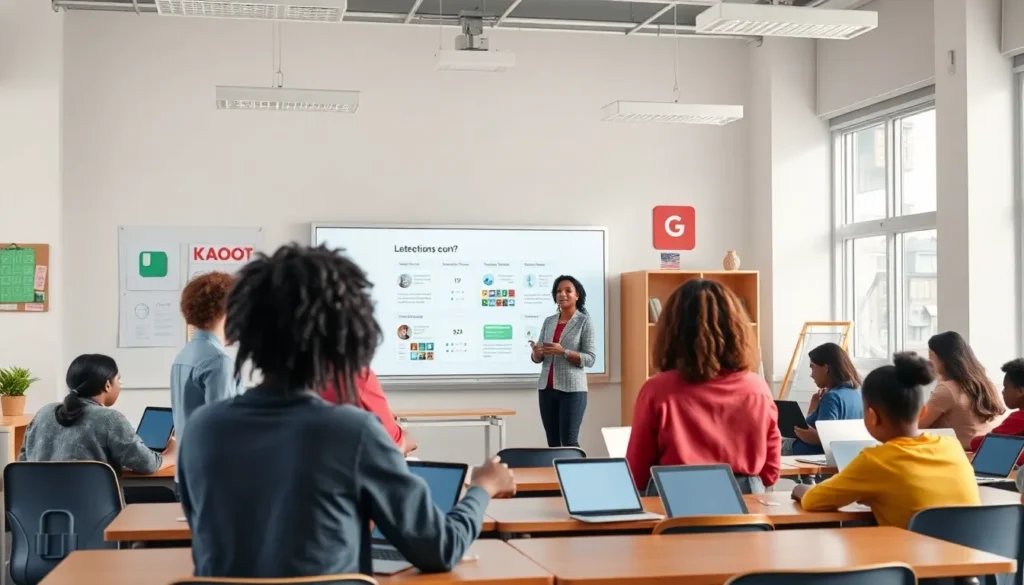Table of Contents
ToggleIn the ever-evolving world of education, teachers are no longer just chalkboard warriors. They are increasingly becoming tech-savvy superheroes armed with digital tools to make learning engaging and effective. Forget about outdated teaching methods: edtech tools are here to revolutionize the way educators teach and students learn. Want to keep your classroom lively while also streamlining your workflow? Buckle up, because this guide will take you through the essential edtech tools for teachers that everyone will be buzzing about.
Understanding Edtech and Its Importance

Education technology, or edtech, refers to the integration of technology into teaching and learning processes. It includes anything from online learning platforms to mobile apps that enhance classroom interaction. But why is it important? Well, edtech tools can aid in delivering personalized learning experiences, making education more accessible, and driving student engagement. By utilizing these tools, teachers can create dynamic lesson plans that resonate with every student, ensuring no one falls behind. Also, they can save time, reduce administrative burdens, and allow for a greater focus on individualized instruction.
Popular Edtech Tools for Classroom Engagement
Among the myriad of edtech tools available, a few standout options have captured the hearts of teachers nationwide.
Google Classroom
This platform simplifies lesson planning and student management. Teacher resources are organized in one centralized location, enabling streamlined communication with students and guardians.
Kahoot.
Kahoot. spices up classroom quizzes and assessments with engaging games. Teachers can create interactive quizzes that students actively participate in, turning review sessions into fun competitions.
Flipgrid
Flipgrid allows students to express their thoughts through short video discussions, fostering communication and critical thinking skills. This tool can transform assignments from static to dynamic, pushing students to engage creatively.
Seesaw
With Seesaw, teachers can build digital portfolios of student work. This tool actively involves parents as they can view their children’s progress, ensuring they’re part of the learning journey.
Enhancing Collaboration and Communication
Collaboration among students and teachers has never been easier, thanks to a growing array of communication-based edtech tools.
Slack
Traditionally a corporate messaging tool, Slack has surged into the educational sphere. It offers teachers a platform to send announcements, share resources, and foster discussions in specific channels, making communication seamless and engaging.
Microsoft Teams
Another powerhouse, Microsoft Teams, provides a virtual classroom environment where assignments can be shared, discussions held, and important meeting notes compiled all in one spot. Teachers can set up team channels for projects, ensuring everyone stays on the same page.
Padlet
Padlet encourages collaborative brainstorming. It works like a digital pinboard where students and teachers can post ideas, links to resources, and images. This tool is perfect for group projects or planning sessions, ensuring that all voices are heard.
Assessment and Feedback Tools for Educators
Assessing student performance has been revolutionized by edtech tools designed to simplify the process and provide instant feedback.
Formative
Formative allows teachers to create assessments that gauge comprehension in real-time. Educators can adjust instruction on the fly based on student responses, ensuring every student truly understands the material.
Socrative
This tool provides a platform for quizzes and exit tickets that yield immediate results. Teachers can determine which concepts resonate with students, informing future lessons and ensuring no one gets left behind.
Google Forms
An oldie but a goodie, Google Forms remains an invaluable tool for surveys and assessments. Its flexibility allows for various question types, and results are conveniently compiled into interactive graphs for easy analysis.
Integrating Edtech Into the Curriculum
The integration of edtech into the curriculum is not just about adopting new tools: it’s about aligning these technologies with educational goals.
Blended Learning Models
Adopt a blended learning approach that combines face-to-face teaching with online learning. This strategy enriches the educational experience by offering diverse learning pathways, catering to different learning styles. Teachers can incorporate videos, games, and online discussions to supplement traditional lessons.
Professional Development
Educators should also invest time in professional development focused on technology integration. Workshops or online courses can equip them with the skills necessary to carry out edtech effectively, enhancing their confidence and competence in the classroom.
Curriculum Mapping
Align tech tools with existing curriculum maps. Ensure that every edtech tool serves a clear educational purpose rather than being used just for the sake of using technology.
Overcoming Challenges in Implementing Edtech
Though the advantages are plentiful, implementing edtech tools does come with challenges.
Resistance to Change
Some educators may be hesitant to adopt new technologies. Encouraging a culture of openness to change is vital. Engaging staff in discussions about the benefits can help foster acceptance and enthusiasm.
Training and Resources
Providing sufficient training is critical. If educators aren’t comfortable using a tool, its effectiveness diminishes. Schools should allocate proper resources for ongoing training so that teachers feel supported and informed.
Technological Barriers
Not all students have equal access to technology. Schools must strive to ensure that all students can use the available tools, whether through providing devices or offering alternatives for those without access.
Future Trends in Edtech for Teachers
As technology continues to evolve, so does the landscape of educational technology.
Artificial Intelligence
AI is set to revolutionize personalized learning. With tools that adapt content and pace based on individual student needs, learning becomes more tailored and effective.
Gamification
Gamification will remain a strong trend, making learning engaging and immersive. Incorporating game-like elements into lessons can motivate students to learn more eagerly, transforming mundane tasks into exciting challenges.
Data Analytics
Data analytics will enhance how educators measure student performance. Using data-driven insights, teachers can identify areas where students struggle and adopt targeted strategies for improvement.







